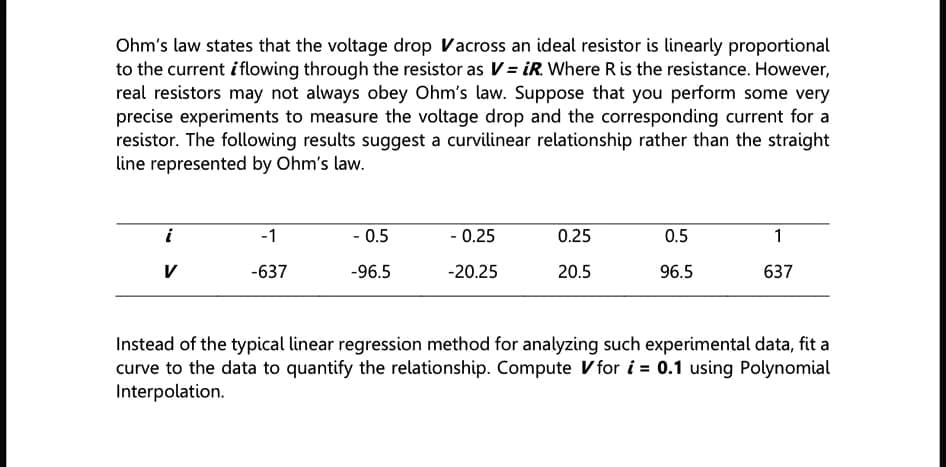Ohm's law states that the voltage drop Vacross an ideal resistor is linearly proportional to the current iflowing through the resistor as V= iR. Where R is the resistance. However, real resistors may not always obey Ohm's law. Suppose that you perform some very precise experiments to measure the voltage drop and the corresponding current for a resistor. The following results suggest a curvilinear relationship rather than the straight line represented by Ohm's law. i -1 - 0.5 - 0.25 0.25 0.5 1 V -637 -96.5 -20.25 20.5 96.5 637 Instead of the typical linear regression method for analyzing such experimental data, fit a curve to the data to quantify the relationship. Compute V for i = 0.1 using Polynomial Interpolation.
Ohm's law states that the voltage drop Vacross an ideal resistor is linearly proportional to the current iflowing through the resistor as V= iR. Where R is the resistance. However, real resistors may not always obey Ohm's law. Suppose that you perform some very precise experiments to measure the voltage drop and the corresponding current for a resistor. The following results suggest a curvilinear relationship rather than the straight line represented by Ohm's law. i -1 - 0.5 - 0.25 0.25 0.5 1 V -637 -96.5 -20.25 20.5 96.5 637 Instead of the typical linear regression method for analyzing such experimental data, fit a curve to the data to quantify the relationship. Compute V for i = 0.1 using Polynomial Interpolation.
Algebra & Trigonometry with Analytic Geometry
13th Edition
ISBN:9781133382119
Author:Swokowski
Publisher:Swokowski
Chapter4: Polynomial And Rational Functions
Section4.3: Zeros Of Polynomials
Problem 67E
Related questions
Question
100%
Need asap pls. Thanks.

Transcribed Image Text:Ohm's law states that the voltage drop Vacross an ideal resistor is linearly proportional
to the current iflowing through the resistor as V= iR. Where R is the resistance. However,
real resistors may not always obey Ohm's law. Suppose that you perform some very
precise experiments to measure the voltage drop and the corresponding current for a
resistor. The following results suggest a curvilinear relationship rather than the straight
line represented by Ohm's law.
i
-1
- 0.5
- 0.25
0.25
0.5
1
V
-637
-96.5
-20.25
20.5
96.5
637
Instead of the typical linear regression method for analyzing such experimental data, fit a
curve to the data to quantify the relationship. Compute V for i = 0.1 using Polynomial
Interpolation.
Expert Solution
This question has been solved!
Explore an expertly crafted, step-by-step solution for a thorough understanding of key concepts.
Step by step
Solved in 4 steps with 4 images

Recommended textbooks for you

Algebra & Trigonometry with Analytic Geometry
Algebra
ISBN:
9781133382119
Author:
Swokowski
Publisher:
Cengage

Algebra & Trigonometry with Analytic Geometry
Algebra
ISBN:
9781133382119
Author:
Swokowski
Publisher:
Cengage